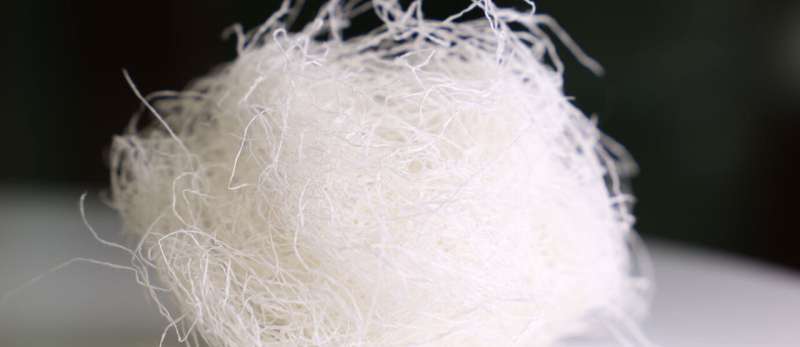Wood-based fiber captures hormones from wastewater

VTT and Aalto University have developed a wood-based cellulose fiber yarn that is an affordable solution for capturing pharmaceutical substances—especially ethinylestradiol in contraceptive pills—that would otherwise end up in bodies of water.
By attaching a cyclic sugar onto the surface of the cellulose fiber yarn, the research scientists were able to create a material that efficiently captures ethinylestradiol (EE2), a hormone used in contraceptive pills. The cyclic sugars are bonded chemically onto the surface of the yarn. The sugars form a pocket into which hydrophobic pharmaceutical substances seek to enter. This way, it only takes a few minutes for pharmaceutical compounds to become bound to the cyclodextrins coupled to the surfaces and cavities of the fiber. Test results demonstrate that one gram of fiber yarn can capture approximately 2.5 milligrams of the hormone.
"Hormone capture would be most effective in wastewater treatment plants and hospitals, since the wastewater in these facilities contains a higher concentration of the compounds. We are developing a wood-based affordable material that could be thrown into a tank in a wastewater treatment plant or used as a filter in a pipe connected to the tank. After some time, the material is collected mechanically. It is disposed of by incineration, but it is also possible to separate the pharmaceuticals and reuse the material," describes VTT's Senior Scientist Hannes Orelma.
The development effort used wood-pulp-based fiber yarn that was manufactured using deep eutectic solvents (DES) in a method developed by VTT. DESes represent a new generation of organic solvents, some of which can be environmentally very friendly. This research used an environmentally friendly DES.
"It would be interesting to test how effectively the cellulose yarns can capture hormones and pharmaceuticals from wastewater at a larger scale," says Orelma.
Hormones and other pharmaceutical agents ending up in bodies of water are a major problem in Central Europe and the United States, where the reported concentrations of estrogen hormones have reached up to 0.83 micrograms per liter. These hormones are called endocrine disruptors, since they affect the gender of fish and turn male fish into females. The EU has identified pharmaceuticals in waters as a challenging problem, since wastewater treatment plants cannot capture the substances efficiently enough. At present, wastewater treatment plants capture pharmaceuticals by means of activated sludge tanks, but a portion of the compounds nevertheless escape the tanks and end up in bodies of water.
More information: Hannes Orelma et al. Cyclodextrin-Functionalized Fiber Yarns Spun from Deep Eutectic Cellulose Solutions for Nonspecific Hormone Capture in Aqueous Matrices, Biomacromolecules (2018). DOI: 10.1021/acs.biomac.7b01765
Journal information: Biomacromolecules
Provided by Aalto University




















